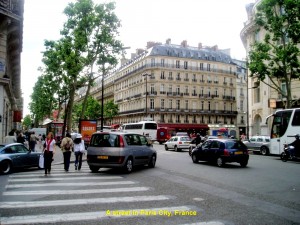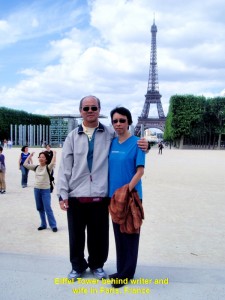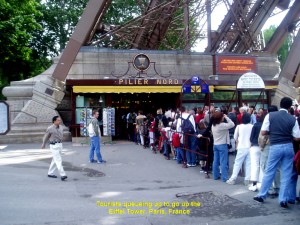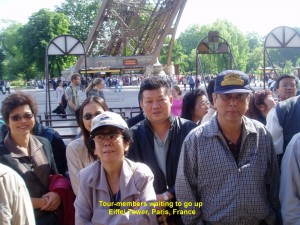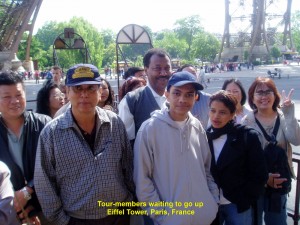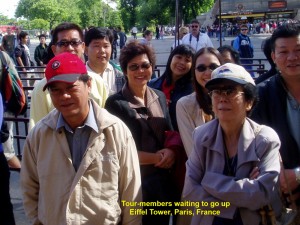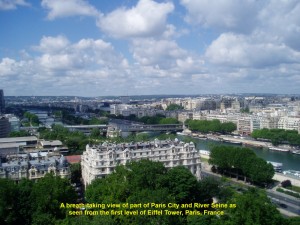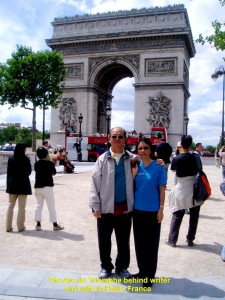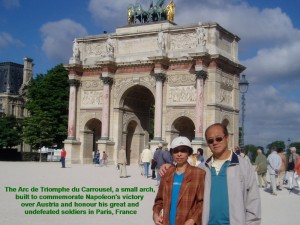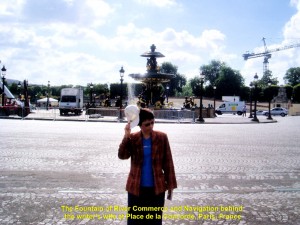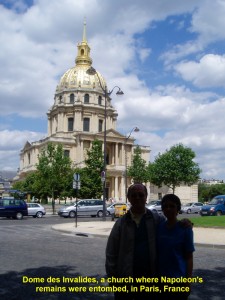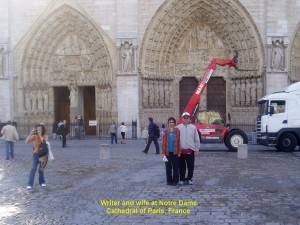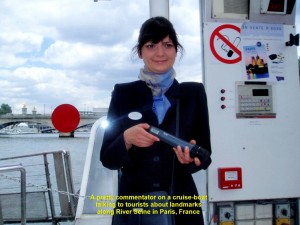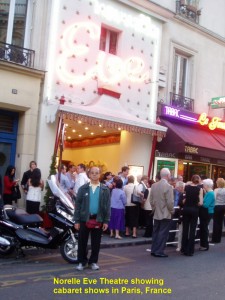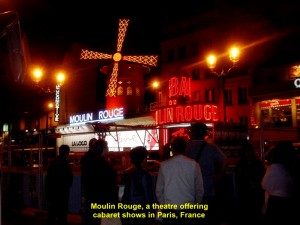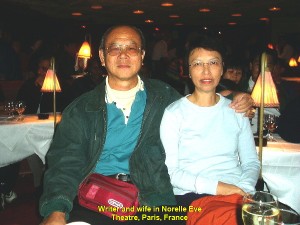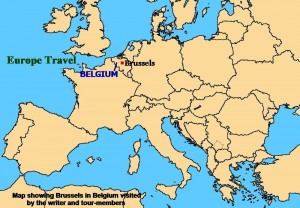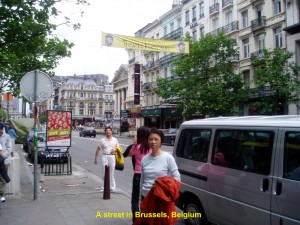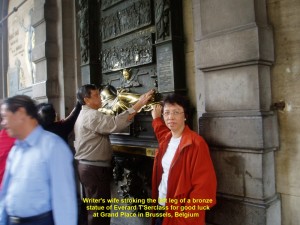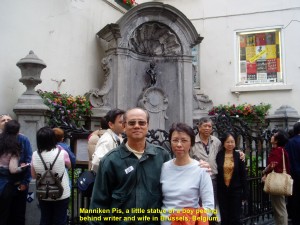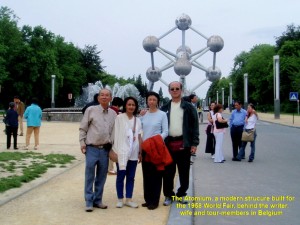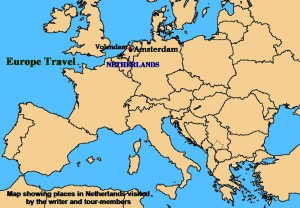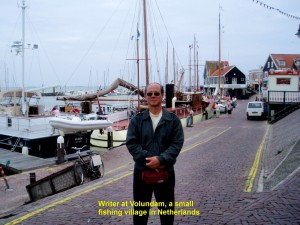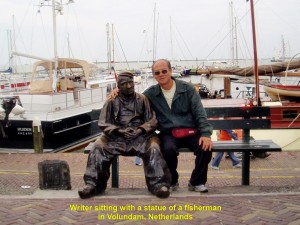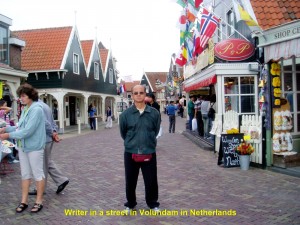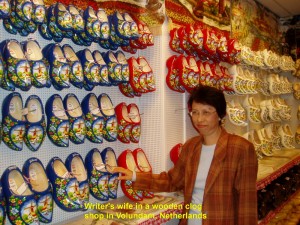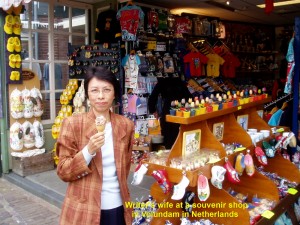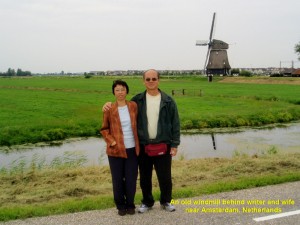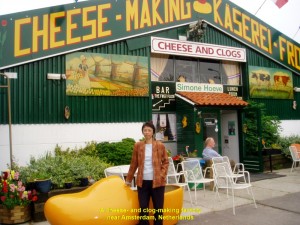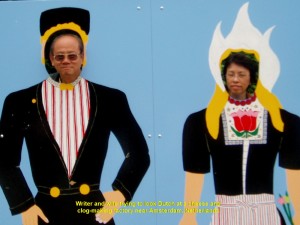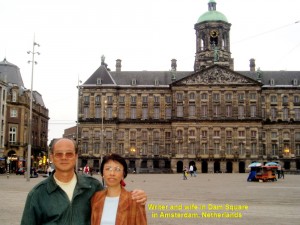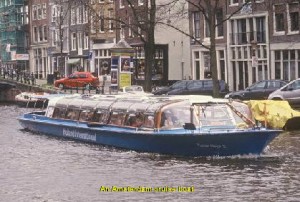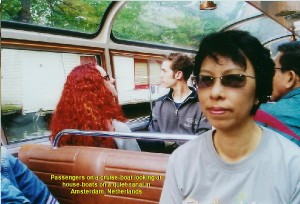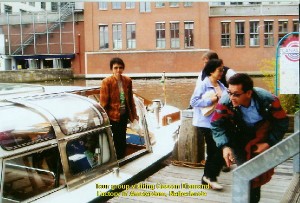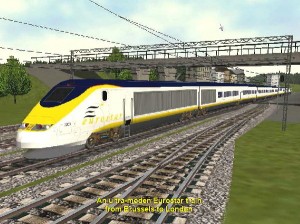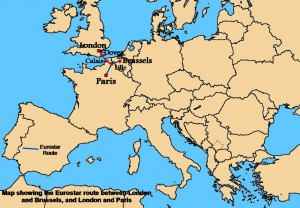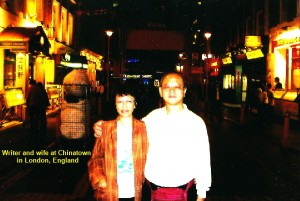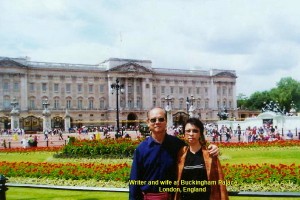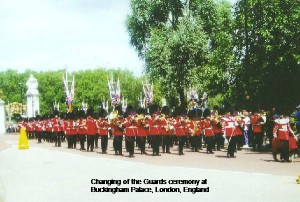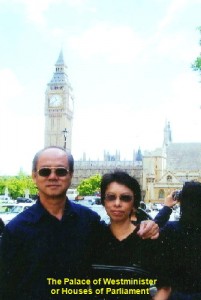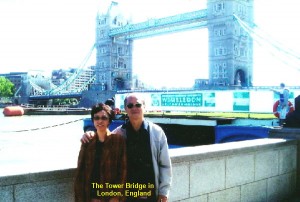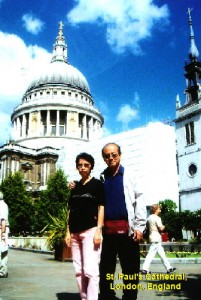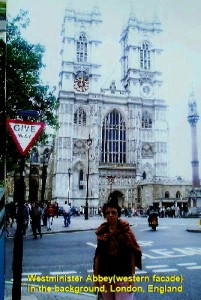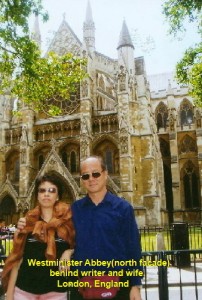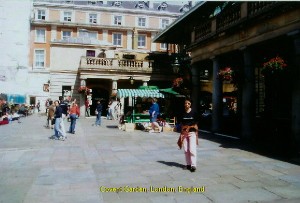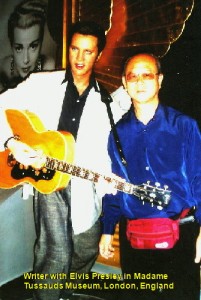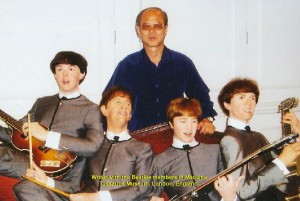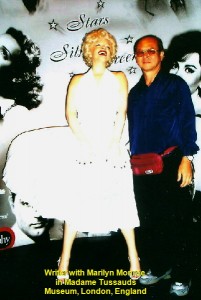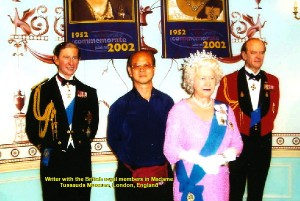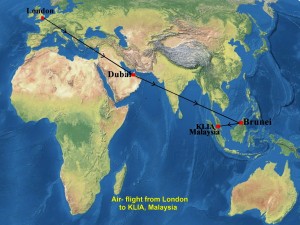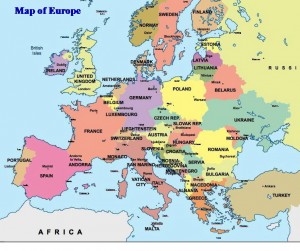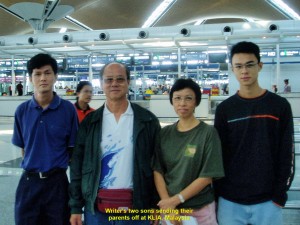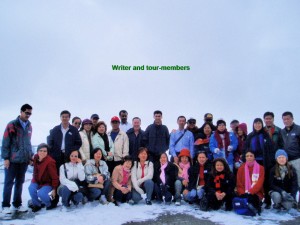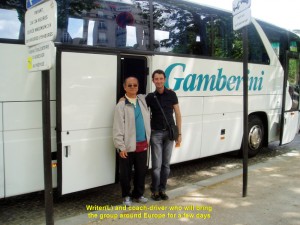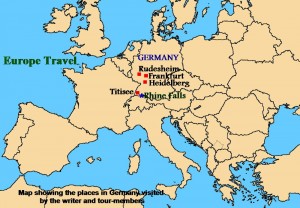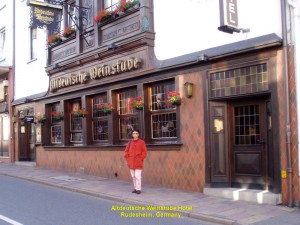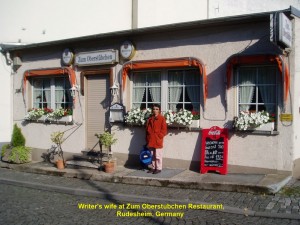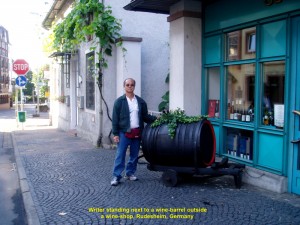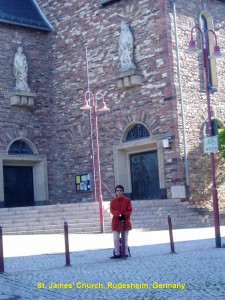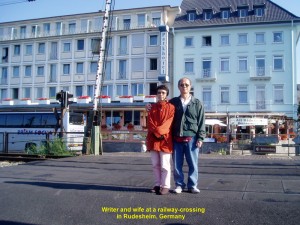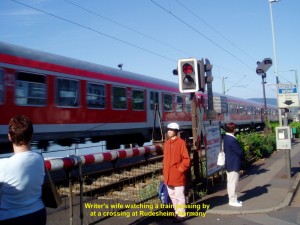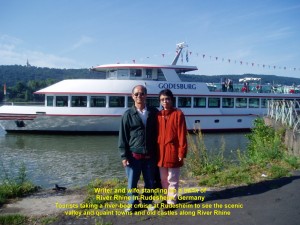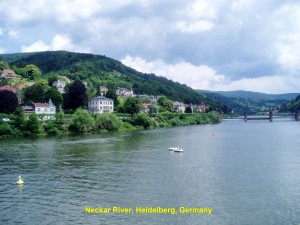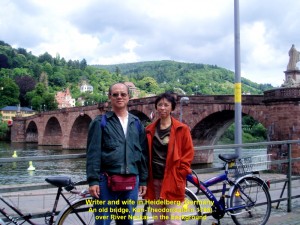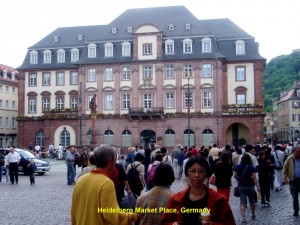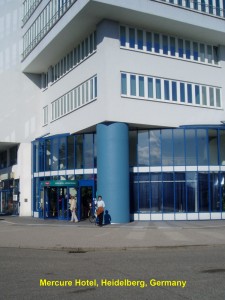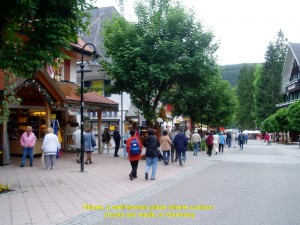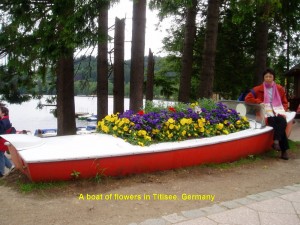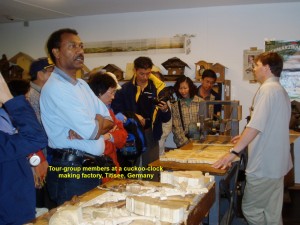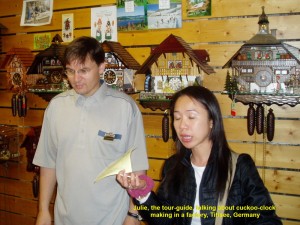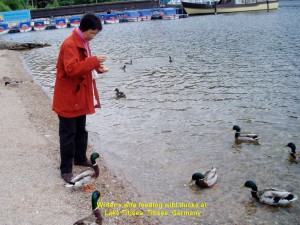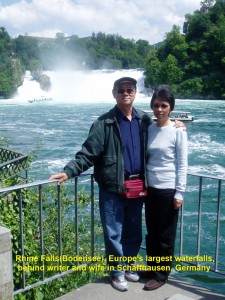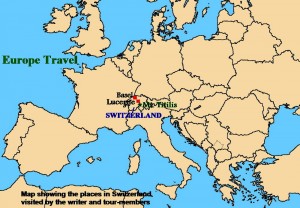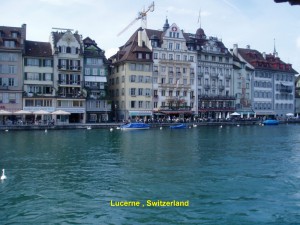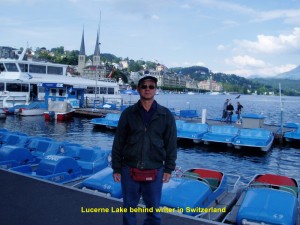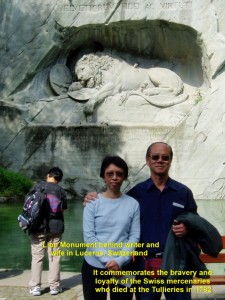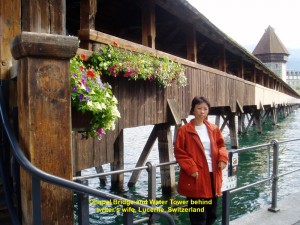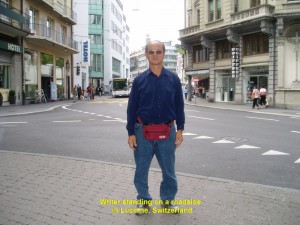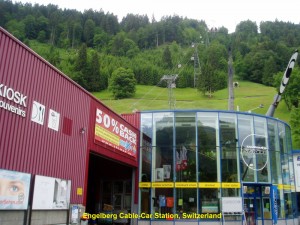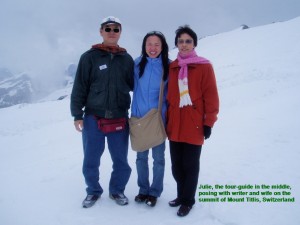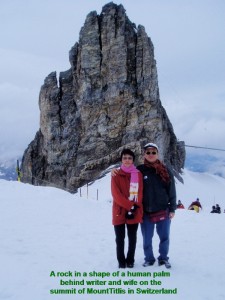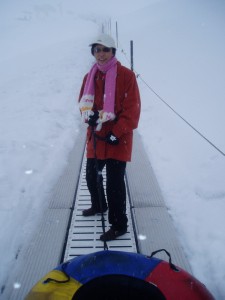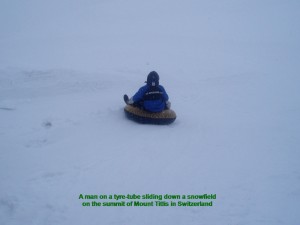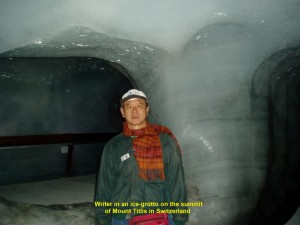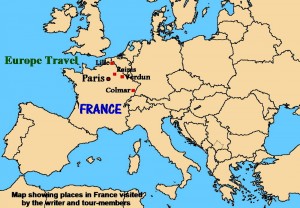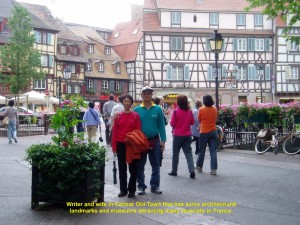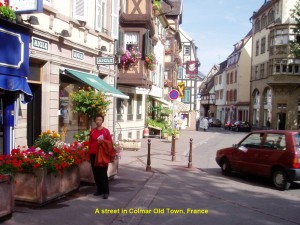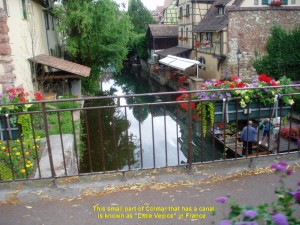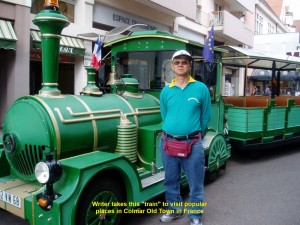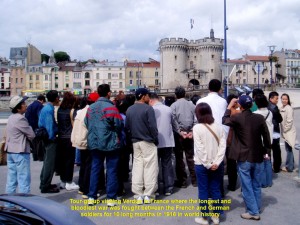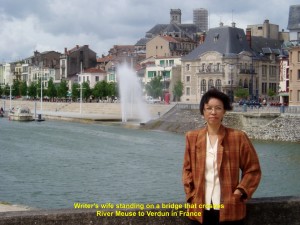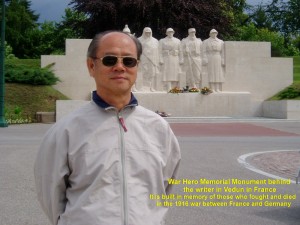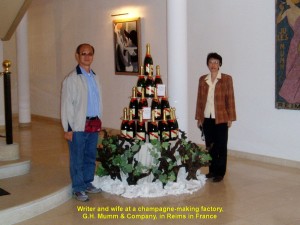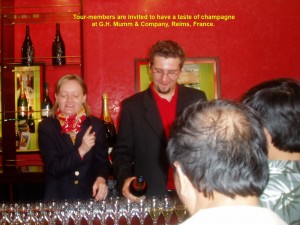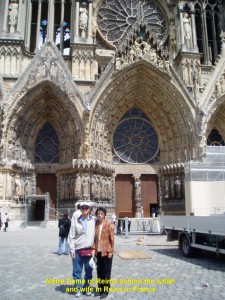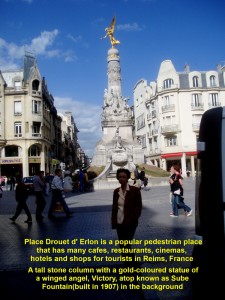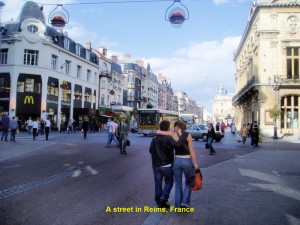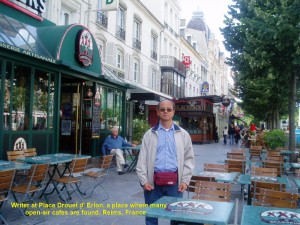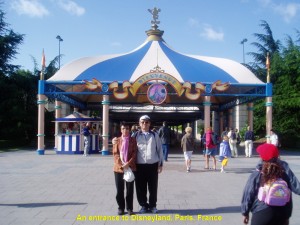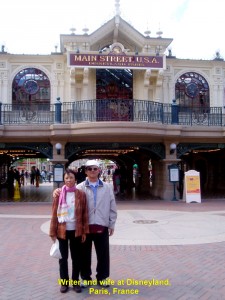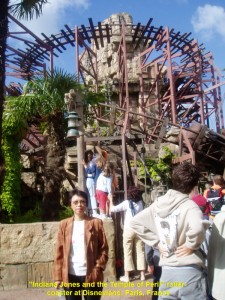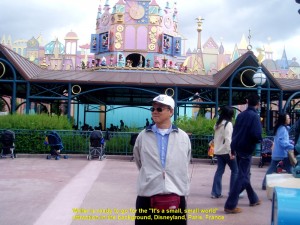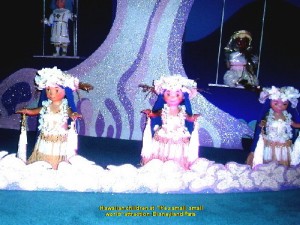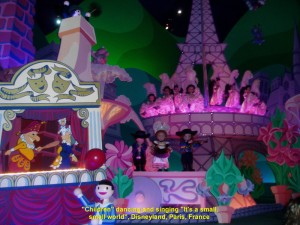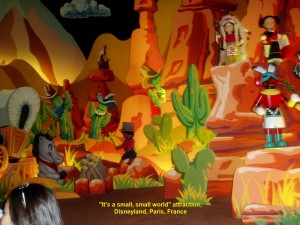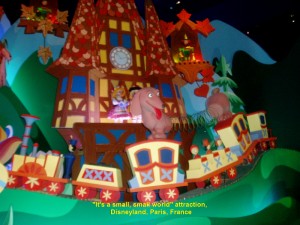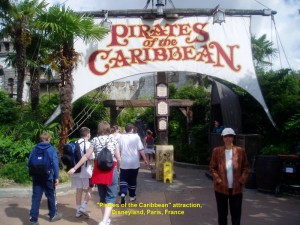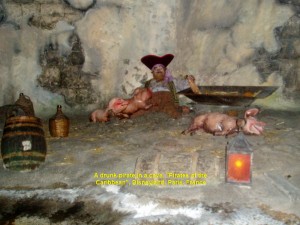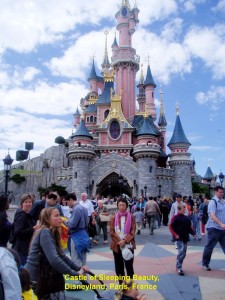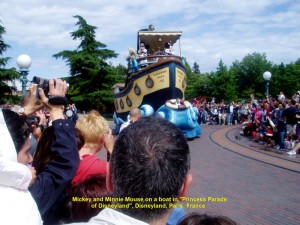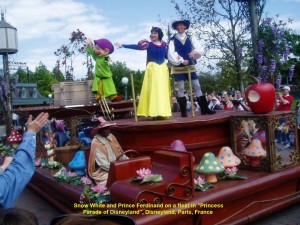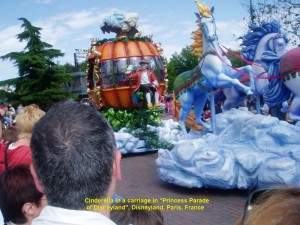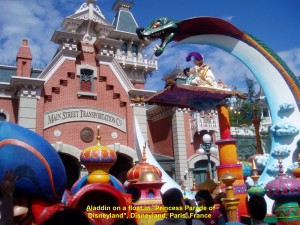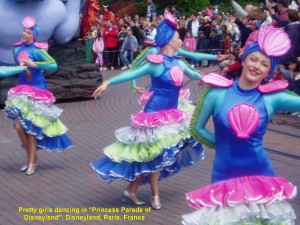Europe Travel (Part II)
Paris
Paris is a vibrant metropolitan city with a large population of 11.5 million. It is the largest city in Europe. Also known as the “City of Lights”, it is rich in history and heritage. Its beautiful, ancient, unique architectural and historical buildings, museums, monuments, cathedrals and other attractions make it one of the world’s major tourist destinations.
When we arrived at Paris, we stopped at a large shopping complex, Lafayette, in Boulevard Haussmann. It offered a wide range of goods, but they were a little bit pricey for us. Later, in the evening, we checked in at Comfort Hotel in rue Regnault.
In the morning, we were ready to tour and enjoy the sights and sounds of the splendid city.
Below are some of the interesting places we visited in Paris:
Eiffel Tower
This beautiful France’s icon, Eiffel Tower, is the most prominent and famous landmark in the city. Built in 1887 and completed in 1889 for the 1889 Paris Exposition, this massive pyramidal-shaped steel structure is 318 m high (including the pole atop the tower). It has three levels: the 1st. level is 57.6m high, the 2nd. 116 m and the 3rd. 276 m.
We went up by an elevator to the 1st. level and walked round the viewing deck. From that level, we could see the spectacular and breathtaking panoramic view of the city.
The Arc de Triomphe
This large, massive arch was built on a big roundabout by Emperor Napoleon Bonaparte to celebrate his victories in other countries and to honour those who fought and died for France in the French Revolutionary. It is adorned with statuettes and tourists can go up to its top to see the whole view of the city. There are 12 busy avenues converging on the roundabout which is known as Place du General de Gaulle.
A smaller arc, Arc de Triomphe du Carrousel, is located near the large one, Arc de Triomphe. This was built by Emperor Napoleon in 1806 to commemorate his victory over Austria and honour his soldiers who fought the wars.
Place de la Concorde
In the vicinity of The Arc de Triumph and along the Seine River is the city’s largest square, Place de la Concorde. At each corner of this octagonal square is a big stone-structure with statues representing one of the eight large French cities: Lille, Strasbourgh, Lyon, Marseille, Bordeaux, Nantes, Brest and Rouen. Standing in the centre of the square is a four-sided stone shaft tapering to a pyramidal point known as Obelisk of Luxor (22.8 m high). It was presented to Louis Phillipe by the Viceroy of Egypt in 1829.
This place is a grim reminder to the Parisians of the turbulent French Revolution days(1789-1799). A French king, King Louis XVI, his Austrian wife, Marie Antoinette, and thousands of other important people were guillotined here.
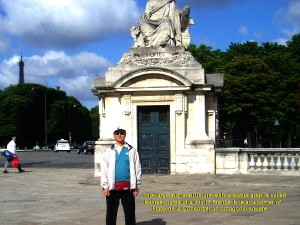
A stone-structure with a statue atop with a name, Nantes, that belongs to one of the French cities in the background in Place de la Concorde Square, Paris
Le Loufvre
This is the richest museum in the world as it houses expensive paintings like “Mona Lisa” and sculptures like “Venus de Milo”.
Dome de Invalides
It was built during King Louis XIV’s rule as a home for the invalids who were disabled and impoverished war veterans. Then it was used as a burial site for the country’s war heroes, including Emperor Napoleon’s remains.
Notre Dame Cathedral of Paris
This grand building of Gothic architectural style was built in the 12th. Century. The facade of the cathedral has three portals laden with statuettes. Above them is a gallery of kings. A large rose-shaped window depicting Virgin Mary is right above the gallery of the kings. It almost resembles the one we saw in Reims.
The cathedral houses some statues like Virgin Mary holding Christ’s dead body on her lap, Joan of Arc, the first bishop, angels, saints, the 12 apostles and King Louis XIII
Besides, beautiful and colourful stained glass windows depicting Virgin Mary, saints and the 12 apostles, and Le Bruns’ religious paintings hanging on a wall can be seen inside.
Seine River Boat Cruise
After the city tour, we went for an hour’s boat cruise on the Seine River which is a busy commercial waterway. As the boat was moving along the river, a pretty, young and smartly-dressed French lady gave us a running commentary on the monuments, historic buildings, bridges and museums as we passed them.
Norelle Eve Cabaret Show
In the evening, we went for a cabaret show at a small theatre, Norelle Eve. It was a decent show for adults. Nearby, there is another theatre, Moulin Rouge, which also offers cabaret shows but it charges more.
Day 8: Saturday 26 June 2004 Brussels, Belgium
Brussels
After breakfast in Paris, we headed north for Brussels, the capital of Belgium and also the capital of the European Union (EU). Belgium is a small country with a population of 10 million.
Grand Place
On arrival, we visited the well-known central market square, Grand Place. Surrounding this beautiful square are well-preserved quaint, ornate Baroque Gothic guild houses dating from the 17th. century. It is surprising to see all these buildings having the same architectural style. The largest building is the City Hall. In the Middle Ages, these houses were given names instead of numbers. Take for example, The House of the Dukes of Brabant which consists of 7 houses each with a different name : The Fame, The Hermit, The Fortune, The Windmill, The Tin Pot, The Hill and The Beurs. In the past, Grand Place was a place for political meetings, execution and receiving VIP”s like emperors, kings and dukes.
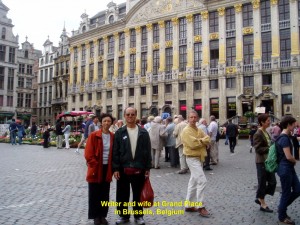
Writer and wife at Grand Place, a well-known market place surrounded by quaint buildings in Brussels
Statue of Everard T’Serclaes
At the Grand Place, there is a bronze statue of Everard T’Serclaes underneath the arcades of Maison de l’Etoile. T’Serclaes was considered a Brussels’ hero in the 14th. century. He was involved in a territorial dispute with the Lord of Gaasbeek. Later, he was ambushed by Gaasbeek’s attackers and died at Maison de l’Etoile. Our tour guide told us that if a person stroked the left leg of the statue, it would bring him/her good luck. No wonder the left bronze leg was so smooth and shiny then!
Manniken Pis / Jenniken Pis
At the corner of Stoofstraat and Rue de L’Euve near the Grand Place is Brussels’ famous icon: Manniken Pis. This black statue of a little, naked boy standing and peeing into a fountain unashamedly has been there since 1619. Surprisingly, there is a black statue of a little girl peeing into a basin at another place near the square. It is known as Jenniken Pis. But less tourists took notice of it.
The Atomium
Later, we travelled north to Netherlands or Holland. On the way, we stopped at Boulevard du Centenaire to admire a gigantic modern structure known as the Atomium. Built in 1958 for the 1958 World Fair, it features a huge iron molecule to honour the metal industry and as a symbol of atomic power.
The Atomium is 102 m high and has 9 spheres representing atoms. Each sphere is 18 m in diameter. They are inter-connected by escalators. In the upper sphere, one can enjoy a panoramic view of the Heysel area and have a meal at a restaurant. Expositions are held in the other spheres. Unfortunately, at that time, we were not able to enter the spheres as they were closed for repair.
Netherlands
We left the Atomium and continued our journey to Netherlands. Dubbed the Land of Windmills, Tulips, Wooden Clogs and Cheese, Netherlans is small and flat . She has a population of 16.2 million. Three quarters of her land is reclaimed from the sea and a large part of the country is below sea-level.
Volundam Our first stop in Netherlands was a small fishing village, Volundam. On arrival, we thought we were welcomed by the colourful bunting and European flags fluttering in the wind. But later we learned that the whole country was in the 2004 UEFA Cup (European Cup) fever as the Dutch team was playing in the well-known soccer game presently held in Portugal. The national team would take on Portugal in the semi-final match on 30 June 2004.
(When we were in London later, we heard that Netherlands lost to Portugal, 1-2. Then on 4 July 2004 the latter was beaten by Greece, 0-1, in the final. So Greece took the 2004 European Championship title.)
Located in the north-west of Amsterdam, Volendam is a peaceful and pleasant place to visit. It was a busy fishing village. Now it is a tourists’ place of interest that offers picturesque scenery. One can sit on a bench on the sea-side watching boats sailing at the sea and enjoying the cool and fresh breeze blowing in from the sea. Besides, one can browse leisurely at small double-storey wooden buildings which sell food, beverages, souvenirs, colourful traditional wooden clogs, apparel and other goods.
After spending more than an hour at the village, we left for Amsterdam. On the way to the city, we stopped for a while at a place to see a large, old windmill which is Netherlands’ icon. Then we headed for a famous cheese and wooden clog making factory.
A Cheese and Wooden Clog Factory Arriving at the factory, we were warmly welcomed by a factory guide. He showed us round the factory and explained the traditional method of wooden clog and cheese making. After that interesting tour, we continued our journey to Amsterdam.
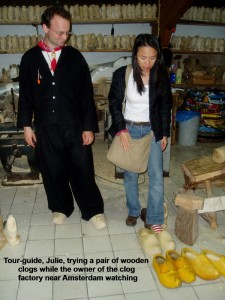
Julie, the tour-guide, trying on a pair of unfinished wooden clogs in the factory near Amsterdam, Netherlands
Amsterdam
Amsterdam is the capital of Netherlands with a population of about 780,000. It is dubbed the “Venice of the North” as it has about 100 canals criss-crossing each other.
Dam Square
The first place we visited in the city was a beautiful square known as Dam Square. It was once a busy market-place.
The large majestic building in the square is the Royal Palace. It was built as the City Hall and was later used by King Louis Bonarparte as his official residence in the 19th. century. This building is now used by Queen Beatrix to receive important dignitaries.
Standing 22 m tall in the square is a national monument which is in the shape of an obelisk. It was erected in 1956 to commemorate the liberation of the city from the German occupation and also to honour the Dutch heroes who fought and died for the nation during World War II.
Red Light District
After a visit to the square, we had dinner and then checked in at Ibis Hotel. In the evening, our tour guide brought us to the city’s famous sleazy Red Light District. When we arrived there, our tour guide warned us not to take photographs of the ladies, otherwise, our cameras might be snatched away and thrown into the watery grave in the canal. Fearing that some of our tour members might think of patronizing the ladies, our guide walked past the bars and brothels, quickly. As we were afraid of losing sight of her in that dimly-lit area, we followed behind her closely. That was indeed a lightning tour and we did not get to see much of the place. We went back to our hotel, Hotel Ibis, and gladly retired to our rooms after a long and exhausting day of sightseeing.
Day 9 : Sunday 27 June 2004 Amsterdam Canal Boat Cruise
In the morning, while waiting for a canal cruise boat, I noticed many bicycles were chained to lamp-posts and railings and some city-dwellers were cycling. As Amsterdam is on a flat land bicycles are a popular means of transport.
Soon, we were all inside a long, low and broad boat. It had a glass-roof so that we could have a wider view outside. As the boat was moving along the canal, we saw house-boats and narrow, old gabled houses with large windows lining both sides of the canal. These old houses are narrow because during the 17th. and 18th. centuries, house-owners were taxed more if their houses were wider. The windows are large so that it is easy to move furniture in or out of the buildings. We saw the world’s narrowest house on Singel 7a. It is only 101 cm wide!
Gassan Diamond Factory
The boat also took us round the Amsterdam harbour. After enjoying the 90-minute boat cruise, we stopped at a famous diamond cutting and polishing factory known as Gassan Diamond Factory. A guide led us to watch workers skilfully cutting and polishing diamonds. After that we were ushered into a room where we could buy diamond jewellery at discounted prices.
Famous Diamonds
Amsterdam boasts of 24 diamond cutting and polishing factories. Many famous diamonds were cut and polished here, e.g. “Koh-I-Noor”, the world’s largest diamond, “Cullinan”, which weighs 3,106 carats and the world’s smallest 0.00012 carat.
Eurostar Travel
In the afternoon, we left Amsterdam and headed straight back to Brussels to catch the ultra-modern train to London, Eurostar. It is a high-speed train from Brussels to London via the Channel Tunnel. The tunnel is under a stretch of water, the English Channel, between France and England. The whole journey takes 2 hrs. 20 mins. Eurostar has been in operation since 1994.
Lille Railway Station Incident
When we arrived at the Brussels Railway Station, we boarded a Eurostar train for London. At exactly 6 p.m., the train started to move out of the station. When it stopped at Lille Railway Station, an announcement came over the air requesting all the passengers to leave the coaches with their luggage. No reason was given but the first thing I could think of was a terrorist’s bomb which must have been planted in one of the coaches. As we were walking away from our coaches to the station, another announcement was made telling us to go back to our respective coaches. Obediently, we turned back and returned to our coaches.
When the train moved again, an announcement came apologizing to the passengers for the inconvenience and explaining that an illegal immigrant had been seen boarding the train and was caught. It was a great relief to all of us as it was not a serious matter. The fear of terrorism then was still fresh in everybody’s mind after the 911 New York tragedy on September 11, 2001.
The Channel Tunnel
Soon, the Eurostar entered the Channel Tunnel and took 20 minutes to go through it whereas a ferry would take over an hour to cross the English Channel. The tunnel is 50 km long and 40 km of it is under the sea-bed. Its average depth is about 46 metres.
Arrival at London On arrival at 8.25 p.m. at Waterloo Railway Station in London, we took a bus to Chinatown to have dinner. After the meal, we checked in at Holiday Inn at Docklands.
Day 10 : Monday 28 June 04 London (England)
London is a vibrant cosmopolitan city with a population of 7 million. It offers countless historical and modern attractions which require several days to visit all. As we had only one day in London, we could visit a few of them.
At 9 a.m., we boarded a coach. The driver told us he would try to bring us to as many popular tourist spots in London as he could..
Below were some of the places we visited on our last day in London:
Buckingham Palace
It was built as a residence for the Duke of Buckingham in 1703. Now Queen Elizabeth and Prince Philip are living there on their working days. Guarding the palace outside are foot guards in their red uniform and tall, furry, black hats. The changing of the guards at the palace takes place at 12 noon daily in summer and every other day in winter. Lady luck was on our side as we arrived in time to watch the grand and unique ceremony.
The Palace of Westminister / The House of Parliament
The English Monarchs lived at this large majestic neo-gothic Italian styled palace until the 16th. Century. Now the House of Lords and the House of Commons conduct their sittings here. It has 1000 rooms including the Chambers of the House of Lords and the House of Chambers. Besides, it has several towers. One of them, the tallest (96.3 metres high), has a clock on each face and houses five bells known as the Big Ben.
The London Eye
From a distance we sighted the world’s largest and tallest Ferris wheel which was 135 m tall. It is now London’s latest landmark, the London Eye. Located in London’s Jubilee Gardens on the South Bank of River Thames, it was opened to public in March 2000. The wheel turns slowly and takes 30 minutes to make a complete circle. It carries people in glass-capsules to the top to enjoy a breathtaking panoramic view of the beautiful city.
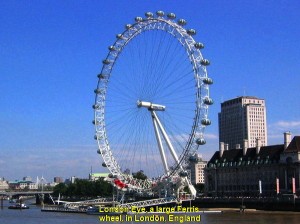
The London Eye, the tallest Ferris wheel in 1999, located on the south bank of River Thames in London, England
Tower of London
It is a well-preserved building and looks like a castle. Over the last 900 years, it has been a fortress, prison, palace, royal mint and zoo. In 1536, King Henry VIII’s second wife, Anne Boleya, was executed there for committing adultery. The tower is now a home to the Crown Jewels and the Yeoman warders (Beefeaters) who are traditional guards.
Tower Bridge
This bridge was built over River Thames and opened in 1894. The two halves of it can be raised so that cruise ships and naval vessels can pass through in its middle. Between the two towers are two high-level walkways open to visitors who wish to have a panoramic view of the city.
St. Paul’s Cathedral
This cathedral is located on the Ludgate Hill. It has an impressive dome and a height of about 108 m. It was built in the late Renaissance to Baroque style in the 17th. Century. Many important services including funerals of famous people like Horatio Nelson, the Duke of Wellington and Winston Churchill had been held at this cathedral. On 29 July 1981, Prince Charles and Lady Diana Spenser were married here. This beautiful cathedral has been used in many movies, like Mary Poppins, Peter Pan, Hands of the Ripper and The Madness of King George.
Westminister Abbey It is a Gothic cathedral which was built in the 11th. century. It has some resemblance to the Notre Dame cathedrals of Reims and Paris. In 1060, the first English king, William the Conqueror, was buried at the cathedral. Later, other kings, queens, poets and other notable figures were also buried there. On 6 Sept. 1997, the funeral of Princess Diana who passed away in an accident in Paris took place at this cathedral. It also holds important marriage, religious and celebratory functions.
Marks & Spenser Having visited some of London’s tourist attractions, we went to a popular shopping complex, Marks & Spenser, in Oxford Street. As the English pound was equivalent to over six times our Malaysian Ringgit, most of us did not shop much there.
The City Hall Located by the Thames River near the Tower Bridge, this building has the most unusual shape: the shape of a huge snail-shell. It is a building opened in 2002 for the headquarters of the Greater London Authority.
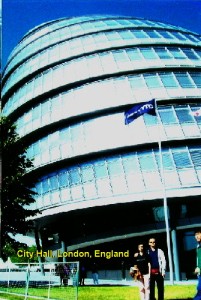
City Hall, the headquarters of Greater London Authority, located near Tower Bridge and opened in 2002
Covent Garden
Covent Garden was once a busy market centre until it was relocated to Nine Elms in 1973. It is now a tourist attraction and also a favourite place for London shoppers who can get good bargains here. It offers lots of goods like handicrafts, jewellery, paintings, antiques, clothing, accessories, fruits and vegetables. Besides shopping, one can watch free street-shows performed by comedians, jugglers, musicians and singers. This place was once a film location for a famous movie called “My Fair Lady” in the 60’s.
Madame Tussauds Wax Museum This is a popular attraction among the locals and tourists alike. In 1835 Madame Tussauds from France opened this London wax museum. It houses wax figures of notorious and notable people. Visitors are allowed to take photos with the life-sized figures of their favourite idols.
When I was inside the museum, I could not resist taking photos with some of the famous figures, like Elvis Presley (the Rock and Roll King), the Beatles (the famous English singing pop group in the 60’s), Michael Jackson (the famous moonwalker), Marilyn Monroe (the sexy and beautiful actress), Kylie Minogue (a famous Australian singer), John Wayne (the husky-voiced and macho cowboy hero), Queen Elizabeth, Princess Diana, and heads of states, like Bush, Tony Blair, Winston Churchill and Adolf Hitler.
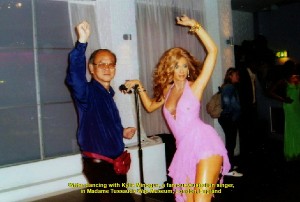
Writer dancing with Kylie Minogue, a famous Australian singer, in Madame Tussauds Wax Museum, London, England
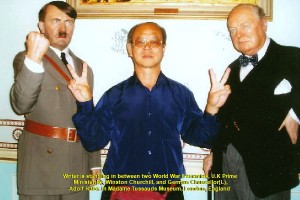
Writer with two WWII enemies, Adolf Hitler and Winston Churchill, in Madame Tussauds Wax Museum, London, England
Day 11 : Tuesday, 29 June 2004 Journey Home ( Malaysia )
At 5.30 a.m., we hurriedly left the hotel, Holiday Inns, in London with our packed breakfast and headed straight for Heathrow Airport. Then at 9.40 a.m. our plane belonging to the Royal Brunei Airlines took off and flew back to Malaysia, our home, via Dubai and Brunei.
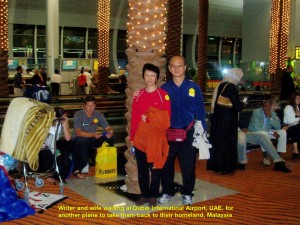
Writer, wife and other tour-members stop at Dubai International Airport waiting for another plane to take them home in Malaysia
Well, that was our memorable trip.
We thank you for reading this travelogue and hope it is useful to you.
Written by: Choo Chaw, Kluang, Johor, Malaysia.
Europe Travel (Part I)
Europe Travel I
Introduction
Europe, one of the five continents in the world, has many beautiful countries.
Its rich histories as well as diverse cultures and traditions lure many interested tourists to the continent. Furthermore, it is a land of splendid landscapes, vibrant cities of stunning old and modern architectural buildings, and lovely people of different nationalities, languages, religions, cultures and traditions.
European Union
Over twenty European nations have formed an association known as the European Union including France, Germany, Italy, Netherlands, Belgian, Luxemburg, Ireland, the United Kingdom, Denmark, Greece, Spain, Portugal, Finland, Sweden and Austria. More and more are bidding to join the union and soon Europe will be known as the United States of Europe (U.S.E).
In 2004, my wife and I joined a Europe tour of 6 interesting countries, viz. Germany, Switzerland, France, Belgium, Netherlands and England, in a very short period of 10 days.
Day 1 : Saturday, 19 June 2004 Departure for Frankfurt (Germany)
On 19 June 2004, my wife and I joined a group of 29 Malaysians at Kuala Lumpur International Airport (KLIA) . After a short briefing from our tour guide, Julie, we boarded a plane and flew to Germany via Brunei. The long journey was smooth except for a brief moment when we encountered a slight turbulence over the Bay of Bengal.
Day 2 : Sunday 20 June 2004 Rudesheim (Germany)
After travelling for 12 hours from Malaysia, we finally landed at Frankfurt Airport in Germany in the early morning. Then we boarded a coach and went to our first destination, a small German town known as Rudesheim.
Rudesheim
Rudesheim is located in the centre of the Rhine River region which is a Unesco World Heritage. It is a small town of about 10,000 dwellers. This peaceful guaint town is surrounded by low hills with vineyards. It has an old castle which houses a museum and a small railway station where passengers can take a train to Koblenz in the east or Frankfurt in the west. River Rhine Cruise boats stop here for tourists to visit this picturesque village.
As it was Sunday when we were there, most of the shops were closed and the streets were quiet. But lots of tourists, mostly Asians, were seen in the town. After spending a short time in the town, we left for another larger German town, Heidelberg.
Heidelberg
Heidelberg is 80 km south of Frankfurt and has a population of over 145,000. It has a picturesque place which is surrounded by densely forested mountains and has a deep wooded valley where a large river, Neckar, flows slowly. Spanning across the river is an old bridge, Karl-Theodor Bridge, built in 1788. It has an arched entrance with twin towers that are capped by spiky helmets. Near the entrance stands a bronze statue of a monkey. There is a local belief that if one can put his/her head inside the monkey’s hollow head without touching its inside, one will be blessed with good luck.
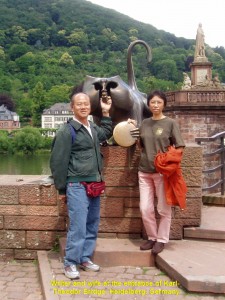
Writer and wife with a bronze statue of a monkey at the entrance of the Old Bridge, Heidelberg, Germany
Standing in the middle of the bridge, one can see an old ruined sandstone castle, Heidelberg Castle (Schloss), on a hill overlooking the valley. It was built in several stages from the 14th. century to the 17th. century. The oldest German university is located here.
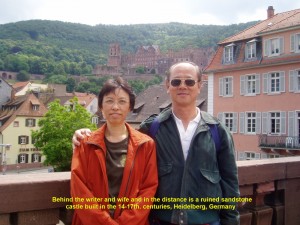
An old castle built in 14-17th. centuries in the distance behind the writer and wife in Heidelberg, Germany
After spending a few hours at the place, we checked in at a hotel, Mercure Hotel, in the downtown. As all the shops were closed on Sunday we retired early.
Day 3 : Monday 21 June 2004 Titisee (Germany)
At 8 a.m., we left Heidelberg for a small village, Titisee, in the lush green pine forests in the mountainous areas.
Titisee
Titisee is a tiny and tranquil village situated at a height of 858 metres above sea-level in the upper Black Forest. It has an oval-shaped lake of clear emerald-green water, Lake Titisee. The lake is 2 km long and 800 m wide. In winter it freezes and offers winter-sports activities like ice-skating, curling and ice-hockey. Surrounding the lake are lush green mountains of unspoilt beauty. Houses with steep roofs (for heavy snow to slide down in winter) are scattered all over the mountain slopes.
A cuckoo-clock factory
At Titisee, we visited a famous cuckoo-clock making factory known as Black Forest Clock Center. The kind owner explained to us the traditional way of making cuckoo-clocks. Then he showed us a wide variety of fine hand-made cuckoo-clocks in his shop. One of our tour members bought one at a price of 400 euro-dollars!.
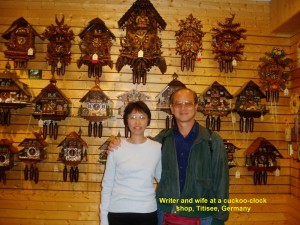
Antique but beautiful cuckoo-clocks for sale hanging behind writer and wife at a Titisee shop, Germany
Then we left the factory and browsed at nearby shops which were selling myriads of goods like dolls, porcelain-figurines, apparels, wooden and plastic cuckoo-clocks and flowers. While walking by Lake Titisee, my wife and I saw some wild ducks swimming in the water. More ducks appeared from nowhere when they saw us throwing pieces of bread to the ducks.
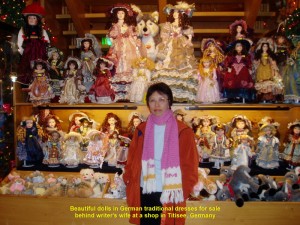
Beautiful dolls in German traditional dresses for sale behind writer’s wife at a Titisee shop. Germany
Rhine Falls (Bodensee), (near Schaffhausen)
After the Titisee visit, we travelled to a place near Schaffhausen to see the Europe’s largest waterfall, Rhine Falls (Bodensee). The waterfall is 150 m wide and 23 m high. It is a spectacular sight to see water cascading down the cataracts. Tourists can take a boat close to the waterfall to feel the power of the thundering water.
On a hill-top near the waterfall stands a medieval castle, Schloss Laufen. In the shallow, crystal-clear water, one can watch large fish swimming about.
Journey to Switzerland
After spending an hour at the waterfall, we left for a long journey to Lucerne in Switzerland. On the way, we saw scenic countrysides, quaint half-timbered cottages, lush green-pine forests and beautiful mountain landscapes in the Black Forest region in south-eastern Germany. Arriving at Basel on the Switzerland border, we passed through an immigration checkpoint without any problem.
Basel
Basel is a small Swiss border town. It is a centre of banking and chemical industries. Its port on River Rhine is Switzerland’s only port.
Lucerne (Switzerland)
Soon, we arrived at Lucerne, a quaint town with many tourists’ attractions, such as medieval squares, frescoed houses, ancient guildhalls, churches and chapels. A river, Reuss, flows from a large lake, Lucerne Lake, through the town. The lake is the 4th. largest in Switzerland.
We visited a few attractions there including the following:
The Lion Monument
An injured and dying lion was curved out of a limestone hill. It is a monument to commemorate the bravery and loyalty of Swiss mercenaries who died at the Tullieries in 1792.
Chapel Bridge
It is a covered wooden bridge built across Reuss River in the first half of the 14th. century as part of the town’s fortification. Old faded 17th. century paintings depicting scenes of the Swiss and local histories can be seen under the roof. The drabness of the bridge is cleverly camouflaged by pretty colourful flowers placed along its sides.
Water Tower
Near the Chapel Bridge is Water Tower, a 34 metre-high tower. It was built in a shape of an octagon in 1300 as part of the town wall. Later, it was used as an archive, treasury, prison and torture chamber.
Lucerne has some shops selling many kinds of Swiss products, such as army knives, cow-bells, watches, chocolates, porcelain dolls, cuckoo-clocks and beer-mugs.
Summer Solstice
In the evening we checked in at a hotel in a mountainous area near Lucerne. I was surprised that the day was still bright at 9.30 p.m. Then I realized that it was Summer Solstice.
Day 4 : Tuesday 22 June 2004 Mount Titlis (Switzerland)
We left Lucerne in the morning and travelled south to a Swiss mountain, Mount Titlis, which is 3238 metres above sea-level.
A Cable Car Ride
On arrival at Engelberg, we went straight to a cable car station at the foot of Mount. We sat in a cable car and were moving slowly up the mountain.
While going up we were surprised to see national flags of the world painted on cable cars. After ascending halfway, we changed to a larger cable car, Rotair, which goes up a steeper slope to the summit. It can rotate slowly as it ascends so that tourists inside can have a 360 degree panoramic view of the breathtaking scenery outside. They can see snow-capped mountains, U-shaped valleys, pine forests on mountain-slopes, scattered houses, green pastures and the Engelberg village.
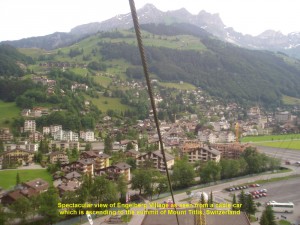
A breathtaking view of Engelberg Village as seen from a cable-car ascending to Mt. Titilis(3238 m), Switzerland
Cow Bells
Halfway up the mountain, we heard sound of umpteen bells that became louder and louder as we approached it. Then, looking out of the window of the cable car, we saw below us cows grazing in the meadows dotted with yellow flowers. We realized that the sound was from the large bells worn round the necks of the cows.
Mount Titlis Summit
When we reached the snow-covered top of Mount Titlis(3238 m above sea-level), we shivered as cold wind was blowing strongly. We left the Rotair and took a lift-chair to a snow-field. Standing on the snow-field, we feasted our eyes on snow-capped Alpine mountains and valleys in the distance. The scenery was awesome. Occasionally, visibility was poor when the air became misty and snow was falling.
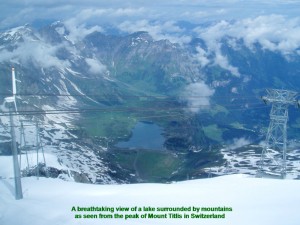
A spectacular view of a lake surrounded by Alpine Mountains as seen from the Mt. Titilis summit, Switzerland
Snow-Field Slide
On the snow-covered summit, many adults and children sitting on tyre-tubes were enjoying a short snow-field slide down a slope. My wife and I went for it, too. It was a rough ride for me. My bottom hit the uneven snow-field all the time. Besides, I had a fright when I was going round a sharp bend.
Ice Grotto
On the peak, there is an ice grotto adjoining the cable-car station. Later, we went down the mountain. As we were descending we enjoyed the beautiful scenery of the place. The we left left Mount Titlis for Colmar in France, a town of 100,000 inhabitants.
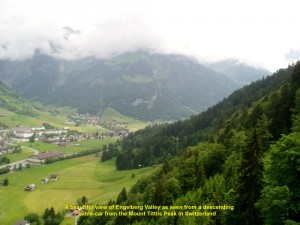
A beautiful sight of Engelberg Valley as seen from a descending cable-car from Mount Titilis Peak, Switzerland
Colmar (France)
Colmar has 100,000 inhabitants. It is surrounded by vineyards and well-known for wine-production. This charming town is also famous for quaint half-timbered buildings such as churches and houses, cloisters, balconies with potted colourful flowers, facades with ornate wood sculpture, paintings, gables and edifices from the Renaissance.
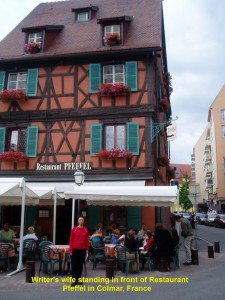
A beautiful half-timbered, quaint building used as a restaurant, Restaurant Pfeffel, in Colamr Old Town, France
The buildings have been well-restored and preserved since the Middle Ages. The streets are narrow and cobble-stoned. One should visit the picturesque small area dubbed “Little Venice” in the leather makers’ district as it has a canal behind colourful half-timbered buildings.
For a small fee, we took a short train ride to see the popular spots in the town.
In the evening, we retired to a hotel known as Novotel Colmar in the town..
Day 5 : Wednesday, 23 June 2004 Verdun (France)
Verdun
In the morning, we left Colmar for a small French town of 25,000 dwellers, Verdun. Located in the north-east of France, Verdun is the place where the longest and bloodiest battle in world history was fought during the 1st. World War. The battle began on 21st. February 1916 when the German soldiers attacked the French soldiers. They fought for 10 long months resulting in heavy casualties on both sides – 328,000 Germans and 348,000 French. The total number of deaths was a staggering 250,000.
We visited the monument in memory of the war heroes near a bridge which is over River Meuse flowing through Verdun. Then we left for Reims.
Reims
Reims has a population of 200,000. It is in a large region of vineyards and a famous centre for producing French champagne.
G.H. Mumm & Company
Arriving at Reims, we visited one of its many well-known wine-cellars, G.H. Mumm & Company. A guide of this company brought us to a large wine-vault where barrels of champagne are stored and explained to us the fine art of champagne-making. Later, we were generously treated to some champagne.
In the lobby of the company, we saw some large Formula 1 Race posters. One of them showed Michael
Schumacher and his boss celebrating the former’s victory in one of the Formula 1 Racing Car Championship races. I guessed the company was sponsoring the champagne for the prestigious race.
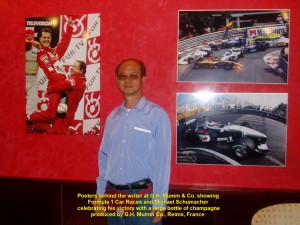
Pictures of Michael Schumacher and Formula One Race on a wall behind writer in G.H. Mumm & Co., Reims, France
Notre Dame of Reims
Thanking the company’s guide, we headed for Reim’s largest and most well-known cathedral, Notre Dame of Reims. It was built in the Gothic architectural style of the 12th. century. Many French kings including King Louis XVI were crowned here.
Its imposing facade has two 81.4 m tall towers, three portals with statues and statuettes, a large, round window in the shape of a rose (rose window) above the middle portal and a gallery of kings above the rose window. Statues and sculptures of religious figures, stained glass, tapestries and paintings depicting religious themes can be seen inside the cathedral. After spending an hour at the cathedral, we checked in at a hotel, Europe Hotel.
Reims Streets
After dinner, we strolled in some Reims streets and noticed that chairs and tables outside cafes and restaurants were a common sight. One can sit there and have a meal, cup of cappuccino or mug of beer. Besides, one can watch people and traffic passing by.
Day 6: Thursday 24 June 2004 Disneyland Paris / Euro Disney, Paris
Early in the morning we left Reims for a world famous theme park known as Disneyland Paris (or Euro Disney) in Paris, France. Located near Paris City, it was officially opened in 1992. It offers a wide variety of attractions for both adults and children. The park is divided into 5 areas, viz.
Main Street USA
Discoveryland
Fantasyland
Adventureland and
Frontierland
Each area offers some interesting and enjoyable attractions.
As we had a whole day to spend at the park, we chose a few of them that we liked, such as the following:
“Dumbo, the Flying Elephant”
It is a slow and relaxing train ride. The train resembling Dumbo, the Flying Elephant in a Disney animated film “Flies”, cruises slowly over the Fantasyland.
“Honey, I Shrunk the Audience”
We watched this short movie with a special pair of spectacles that gave us a 3-D virtual reality experience. The story was about Professor Szalinski who used his new contraption and accidentally “shrunk” the audience. While watching the movie, we felt as though we were involved in it. We could feel mice running around our feet trying to escape from a large, grey cat. We felt uneasy when the cat came out of the screen and stared at us closely for a long time before it disappeared. Later, a huge venomous snake suddenly appeared in front of us and looked at us fiercely. We felt a rush of adrenalin to our brains when it opened its large mouth showing its long, sharp fangs. Then it quickly “swallowed” us up. It was truly a virtual reality and scary experience!
“Star Wars”
We joined a very long queue for a 10-minute flight simulator ride in a “space craft” in the “outer space”. It offered us an exciting intergalactic travel adventure, Star Wars. The most thrilling moment in the adventure was when our “space craft” manoeuvred quickly to avoid the attack by several enemy “space-crafts”.
“Indiana Jones and the Temple of Peril”
This is a rough and jerky roller-coaster ride. My wife and I sat together on a hard seat in a “mine-car”. As it moved backwards all the time we did not know what to expect behind us. We felt shocked when it, suddenly, made a complete vertical loop. My spectacles nearly fell off when I was upside down. After the short ride we felt a bit shaky.
“It’s a Small, Small World” Sitting in a boat, my wife and I cruised round the “world” watching “children” of different nationalities (little pretty dolls in their national costumes) dancing and singing a beautiful children song, “It’s a Small, Small World”. During that short ride, we felt we were children again.
“Pirates of the Caribbean”
This attraction shows scenes of pirates’ lives. As we went through the scenes we could hear voices of the pirates and victims. We learned that the pirates were violent and merciless creatures. They attacked, robbed and burnt ships and villages, killed, drank and gambled.
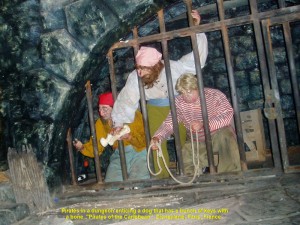
Pirates in dungeon enticing a dog with a bone at “Pirates of the Caribbean’ attraction, Disneyland Paris
Sleeping Beauty Castle
On the ground floor of this large magnificent castle, there is a legendary dragon sleeping in its lair. Occasionally, it wakes up and blows out a big fire. Upstairs, tapestries and beautiful stained glass windows depicting the Sleeping Beauty’s story can be seen.
Princess Parade at Disneyland
The highlight of the day at Disneyland starts at 4 p.m. It is the “Princess Parade”. During this awesome parade, all the characters in the Disney animated films turn up, such as Mickey and Minnie Mouse, Beauty and the Beast, Cinderella and her Prince Charming, Sinbad and his pretty lady, Snow-White and the Seven Dwarfs, and many more. They appear on large and colourful slow-moving floats waving happily to the spectators.
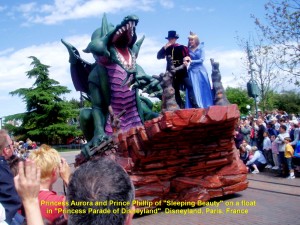
Princess Aurora and Prince Phillip of “Sleeping Beauty” on a float in the “Princess Parade of Disneyland”, Disneyland Paris
In front of the parade, beautiful ladies and handsome gentlemen in striking colourful costumes dance, gracefully and happily, to the tune of a loud music coming from big loudspeakers placed at strategic places. This is truly a colourful and spectacular event no visitor should miss.
After a day of fun, excitement and adventure at Disneyland, we reluctantly left for Paris City in the evening.
(Continued in Europe Travel Part II)
Written by Choo Chaw, Kluang, Johor, Malaysia.

